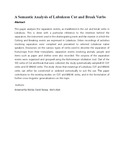| dc.contributor.author | Wafula, Annemartha | |
| dc.contributor.author | Barasa, David | |
| dc.contributor.author | Alati, Atichi | |
| dc.date.accessioned | 2023-02-03T07:51:57Z | |
| dc.date.available | 2023-02-03T07:51:57Z | |
| dc.date.issued | 2023-01-12 | |
| dc.identifier.uri | https://www.royalliteglobal.com/njhs/article/view/994 | |
| dc.identifier.uri | https://doi.org/10.58256/njhs.v7i1.994 | |
| dc.identifier.uri | http://ir-library.mmust.ac.ke:8080/xmlui/handle/123456789/2164 | |
| dc.description.abstract | his paper analyses the separation events, as manifested in the cut and break verbs in Lubukusu. This is done with a particular reference to the intention behind the separation, the instrument used in the disintegrating event and the manner in which the Cutting and Breaking events are expressed in Lubukusu. Video recordings of activities involving separation were compiled and presented to selected Lubukusu native speakers. Discourses on the various types of verbs used to describe the separation of fruits/crops from their trees/plants, separation events involving animals, people and items such as paper and clothes were also recorded. The corpora of the separation events were organized and grouped using the Bohnemeyer elicitation tool. Out of the 100 verbs of Cut and Break that were collected, the study systematically sampled 30 CUT verbs and 20 BREAK verbs. The study shows that meanings of Lubukusu CUT and BREAK verbs can either be constricted or widened contextually to suit the use. The paper contributes to the existing studies on CUT and BREAK verbs, and in the formulation of further cross-linguistic generalizations on this topic. | en_US |
| dc.language.iso | en | en_US |
| dc.publisher | Nairobi Journal of Humanities and Social sciences | en_US |
| dc.subject | Semantic, Analysis, Lubukusu, Cut, Break, Verbs | en_US |
| dc.title | A Semantic Analysis of Lubukusu Cut and Break Verbs | en_US |
| dc.type | Article | en_US |

